Vancouver is a metropolis in Western Canadian and it as arguably one of the most beautifully located cities in the world, and nature alone in and around it makes any trip to here an unforgettable experience.
Vancouver is named after George Vancouver, who was the first European to come ashore in the area. It happened in 1792, and since then a colossal development has taken place here. Vancouver is one of Canada’s largest cities, and it is the economic and tourist locomotive of British Columbia; sharply followed by cruises and trips to the Victoria and Rocky Mountains, which are all easy accessible from Vancouver.
The metropolis offers almost all kinds of sights and activities within the city limits. Stanley Park is almost like getting out into the great Canadian nature, and just a few minutes walk away from downtown Vancouver. Seen from the park, the many high-rise buildings in Vancouver provide an intriguing contrast to the green surroundings and the ocean front.
Stroll the streets of downtown Vancouver and enjoy not least different architectural styles from the late 1800s to the present day. In early Vancouver, however, it was Gastown that made up the city, and today it is one of Vancouver’s most charming neighborhoods and a must-visit during a stay.
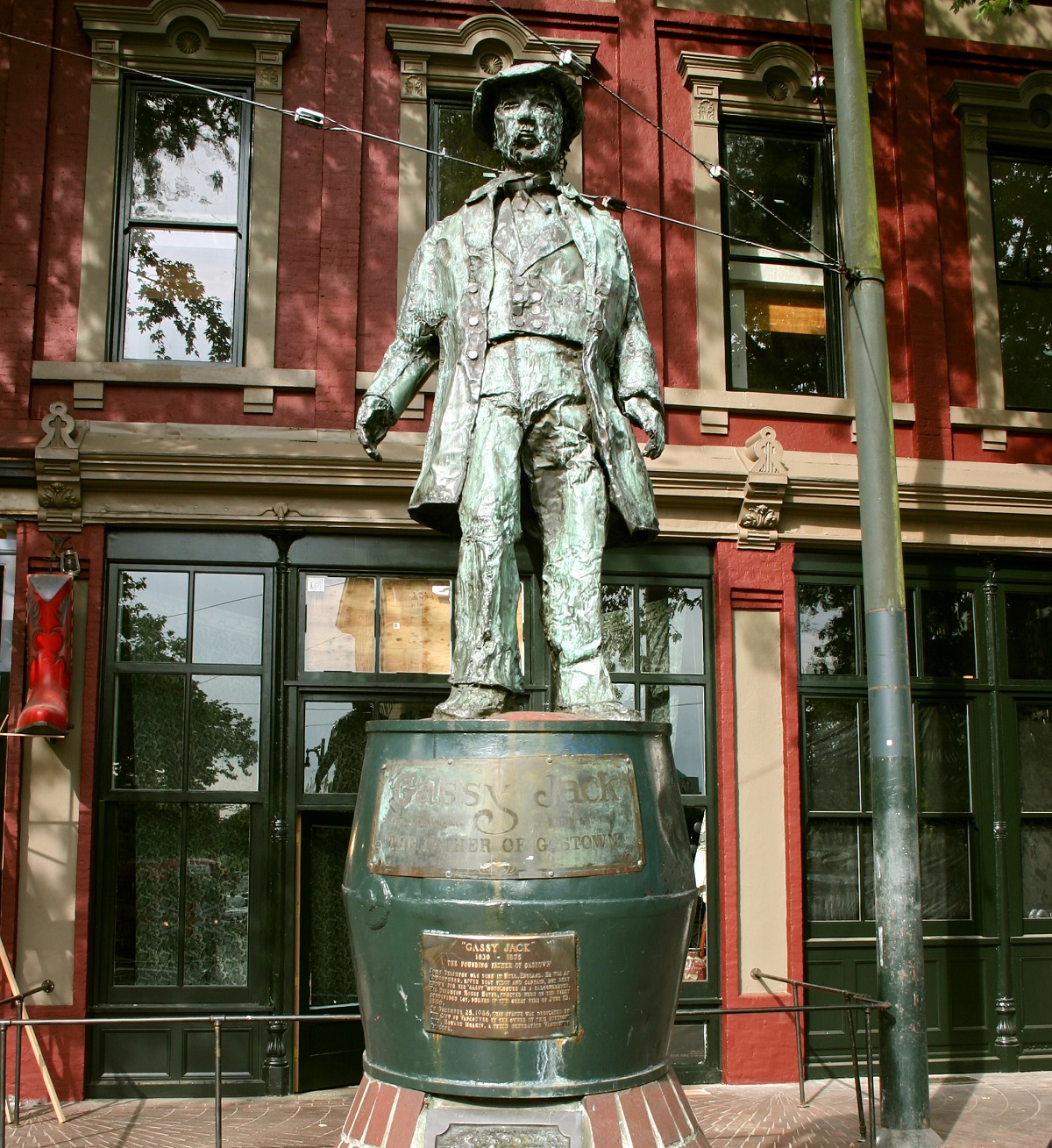
Gastown is Vancouver’s oldest district, but compared to many other cities in the world, Gastown is also relatively new. In 1867 there was only a sawmill here, but after the arrival of John “Gassy Jack” Deighton, a saloon was first built and then other buildings, and that was the beginning of Gastown, which from 1870 was officially called Granville.
Over time, parts of Gastown have been destroyed by fires and demolished, and new buildings have been added. Today, the district is a mixture of old and new, and with its cobbled streets, gas street lamps, small shops and many restaurants, it is particularly atmospheric. It’s just a matter of exploring the relatively manageable district.
The name Gastown came from John Deighton’s nickname Gassy Jack, which he gave to his many fantastic stories, which were said to be full of hot air or gas.
The Harbor Center is a skyscraper with an observation deck in central Vancouver. The building and accompanying tower were opened in 1977, and at the time it was Vancouver’s tallest building.
At a height of 168 metres, the observation deck is the Harbor Centre’s main attraction. From here you have a classy 360o view of Vancouver’s high-rises, neighborhoods and the magnificent surrounding nature. Immediately below the observation deck itself, there is a rotating restaurant where you can sit in peace and quiet while you eat and enjoy the view. The trip up the tower is an experience in itself. You ride in glass elevators from street level to the viewing level. The trip takes 40 seconds.
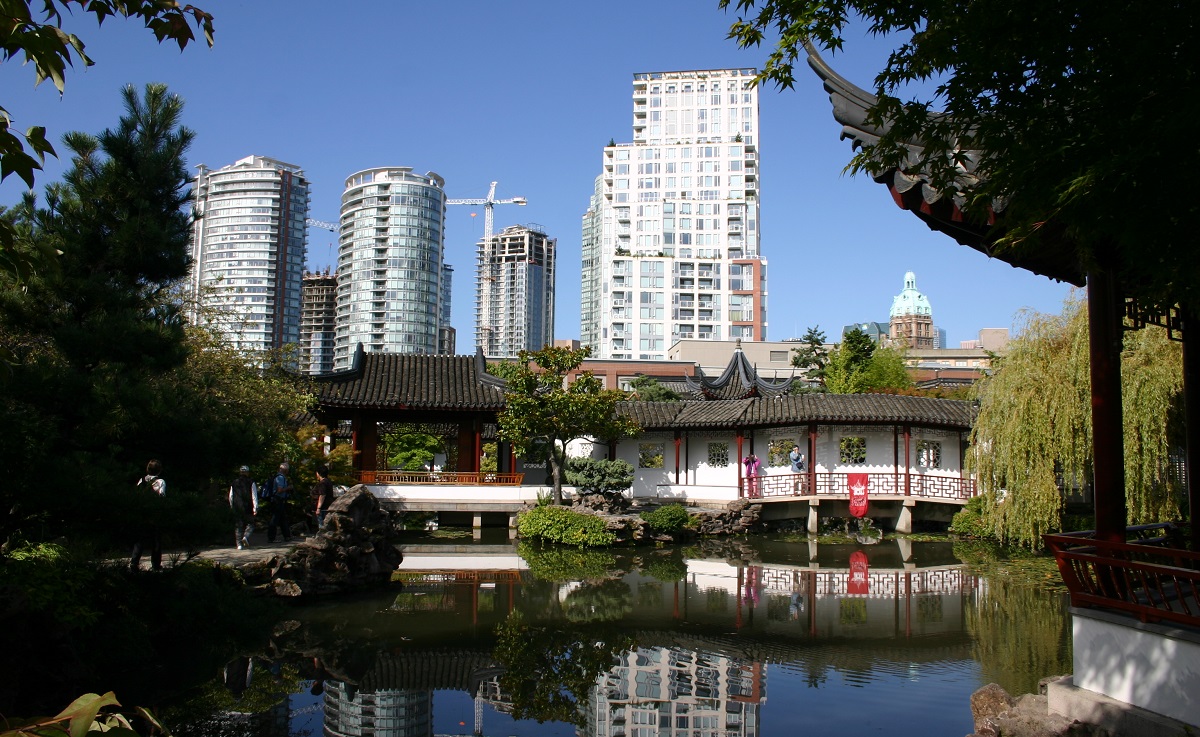
Sun Yat-Sen Classical Chinese Garden is a garden that was established from 1985-1986 as the first classical Chinese garden to be established outside of China. The garden is a wonder for the senses with its varied and elegant interior design. Here are houses and pavilions, miniature trees and inspiration from the beautiful grounds of the Ming Dynasty.
Stanley Park on the peninsula at Burrard Inlet is one of Vancouver’s most visited and popular places. In the large park, there is lovely nature with hiking trails, various Canadian animals, nicely landscaped gardens, totem poles and not least the Prospect Point viewpoint, from which there is a fine panoramic view of the mountains to the north, Burrard Inlet and the majestic Lions Gate Bridge.
Stanley Park is a large park that is almost surrounded by water in the form of English Bay to the west and Burrard Inlet and Vancouver Harbor to the east. The park area has been used by the pre-European population for many centuries, and more recently the site was laid out as a park in 1886 and named after the Governor-General Lord Stanley. It happened after the beginning of settlement on the peninsula by Europeans who had settled at Brockton Point and on Deadman’s Island to the east in the present park.
There is a wealth of experiences in Stanley Park. You can simply take a walk in the park and enjoy the green surroundings or go specifically for some of the activities and famous places located here. An example of a longer walk is along The Seawall, which goes around the park along the water. The Seawall was established from 1917 to 1980, and the trip is nine kilometers long.
Along the way around and through the park, there are a large number of monuments and statues. Among them is naturally enough one of Lord Stanley. Most people will probably also walk past the park’s famous totem poles and to The Nine O’Clock Gun, which stands at the far east of the park.
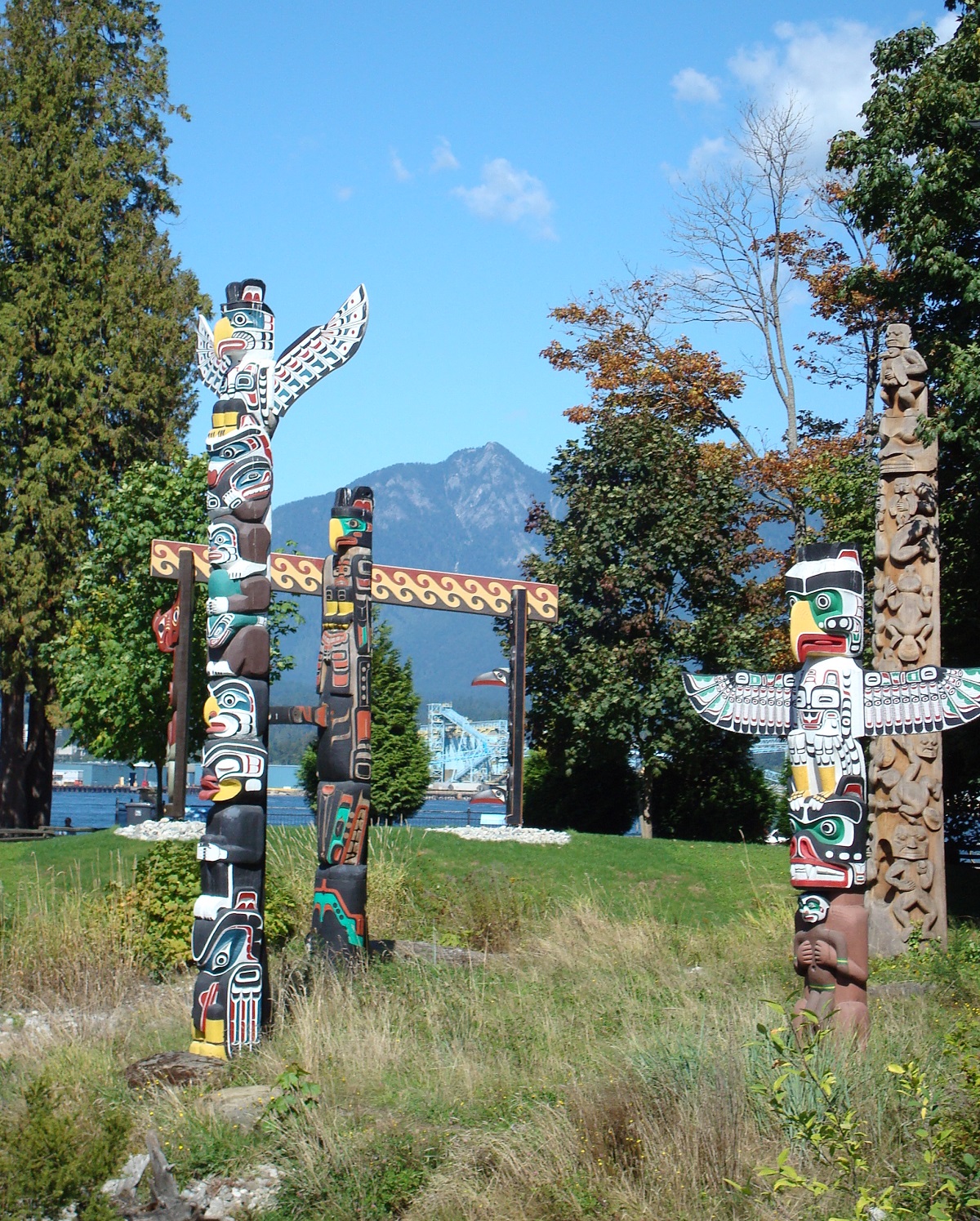
One of the main attractions in Stanley Park is located at the Brockton Point landmark and not far from the Brockton Point Lighthouse. Here you can experience a number of totem poles. The totem poles are original Native American poles, which for the most part have been moved here from other places where they originally stood.
Some of the poles were cut in the 1880s, while others date from the decades after 1900. They come from the Alert Bay, Queen Charlotte Islands and Rivers Inlet areas, and they give a good impression of the crafts and culture of the area’s indigenous people.
The Museum of Vancouver is a fine museum that, through exciting exhibitions with many effects, depicts the city’s history from the time of the Indians to the arrival of the first Europeans to the time when Vancouver rapidly developed from a small trading post to a modern North American metropolis.
At the museum you can also see exhibitions about the history and culture of other peoples and countries around the Pacific Ocean, just as many effects from other parts of the world are also exhibited. They come, among other things, from Egypt and places in the British Empire.
The initiative for the museum was taken by a group of citizens in 1894. 11 years later, the museum moved to the beautiful Carnegie Library building, before the current futuristic museum building was completed in 1968. The building was designed by architect Gerard Hamilton.
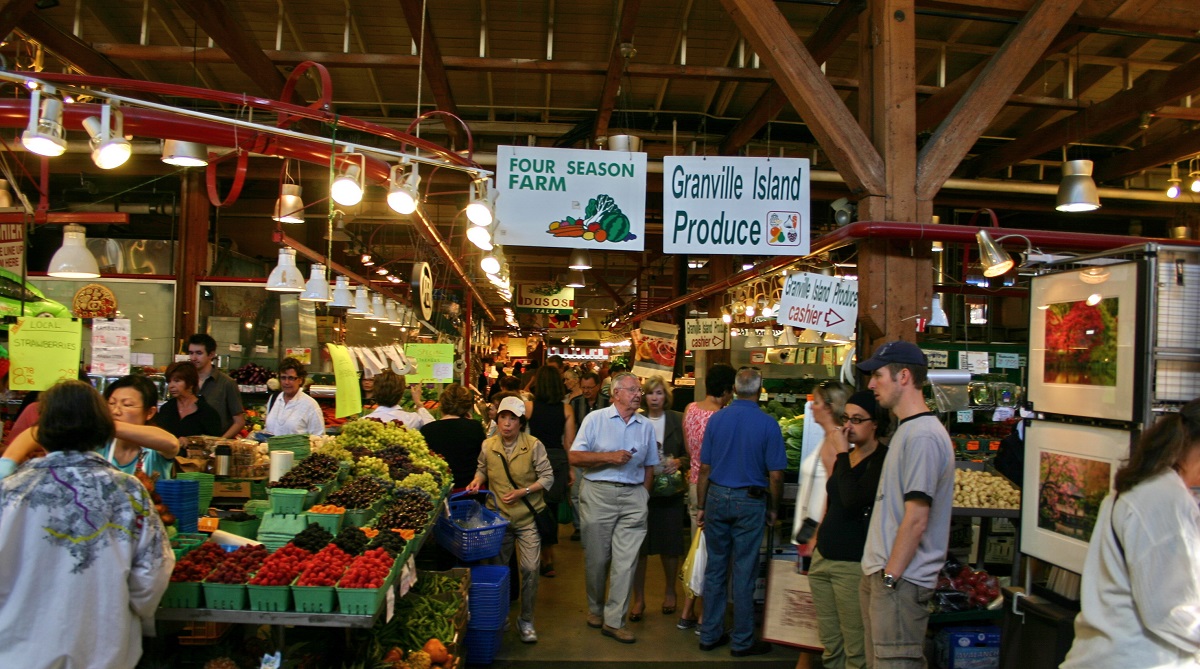
Granville Island is a small peninsula located immediately south of downtown Vancouver. The peninsula was once known for housing a number of manufacturing companies, while today it is a popular place for locals and tourists due to its large market, the many places to eat and other activities. The Granville Island Public Market, which offers, among other things, locally produced goods and various foods, is the best-known place on the peninsula.
You can sail to Granville Island from downtown Vancouver, but you can also drive by road under the big bridge, the Granville Street Bridge. The bridge spans False Creek and is the third at this site. The first opened in 1889, the second in 1909 and the current one in 1954. The bridge’s street plan is a good 27 meters above Granville Island.
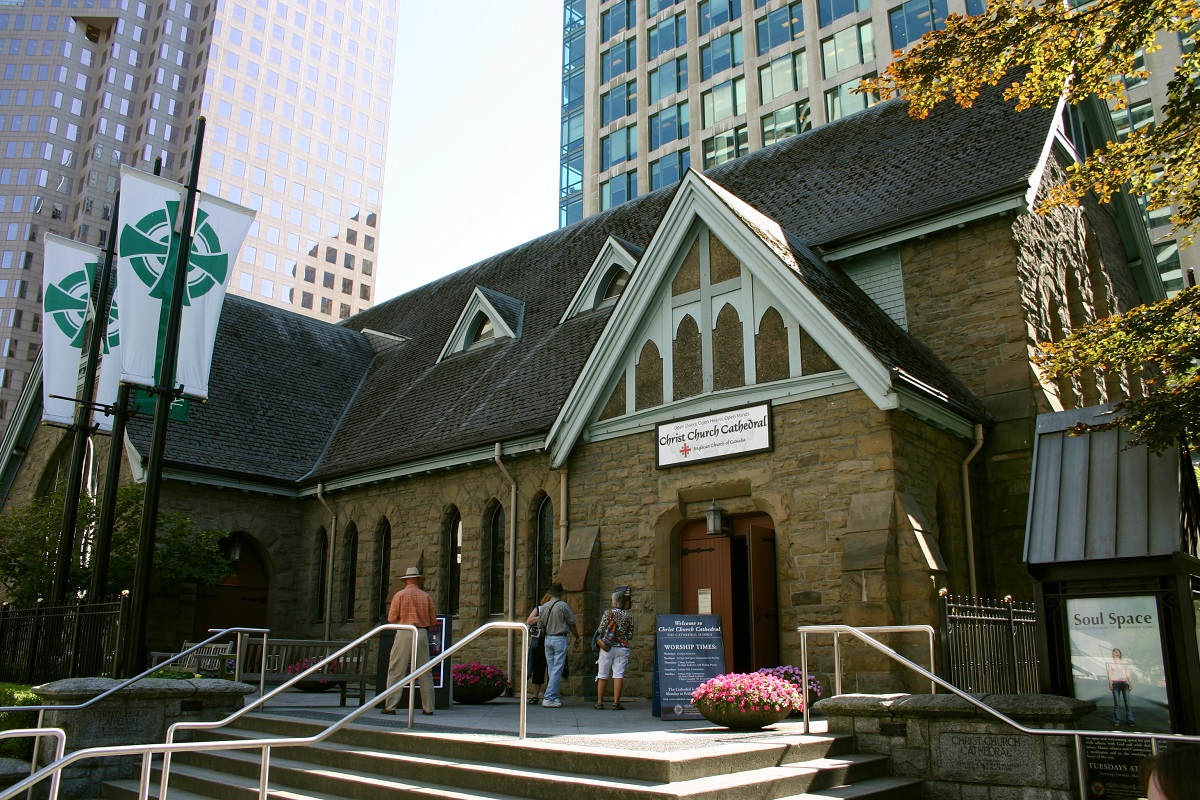
Christ Church Cathedral is the main Anglican church in Vancouver. The first steps towards the construction of the church were taken in 1888, and the following year the first service was held for 52 parishioners in a building which the surrounding landowners did not think was worthy of a church.
There was a pronounced local desire to build a new church. In order to succeed in the wish, shares were sold and loans were taken out. After that, the construction of today’s church could start, and the church was built in 1894-1895 in neo-Gothic style. Inside you can see, among other things, 32 glass mosaics that were prepared in England and Canada respectively.
Today, the church, which at the time of construction was of considerable relative size in the cityscape, stands as a low building among surrounding high-rise buildings. It provides a good contrast in the urban space and emphasizes the development that Vancouver has undergone since the end of the 1800s.
Vancouver is home to North America’s second largest Chinese population and the largest in Canada. In the streets Pender Street and Keefer Street, the Chinese make their mark, not least with shops and restaurants like in their home country, and collectively the area is called Chinatown.
Also in Pender Street, you can see the Chinese gate with the name Millennium Gate. Various Chinese festivals and traditions are celebrated in style in this neighborhood; e.g. the Chinese New Year. In the streets of Chinatown, you can also notice details in the decoration. The street lamps are an example of the Chinese style, deliberately installed to give the neighborhood a distinctive character.
The Chinese population traditionally lived in this area of the city, but from the 1900s to today, they have spread more throughout the city area. As a result, there is not the same concentration of Chinese culture and daily life as there has been in the past. A kind of new Chinese trade center has also seen today’s life in the Richmond district.
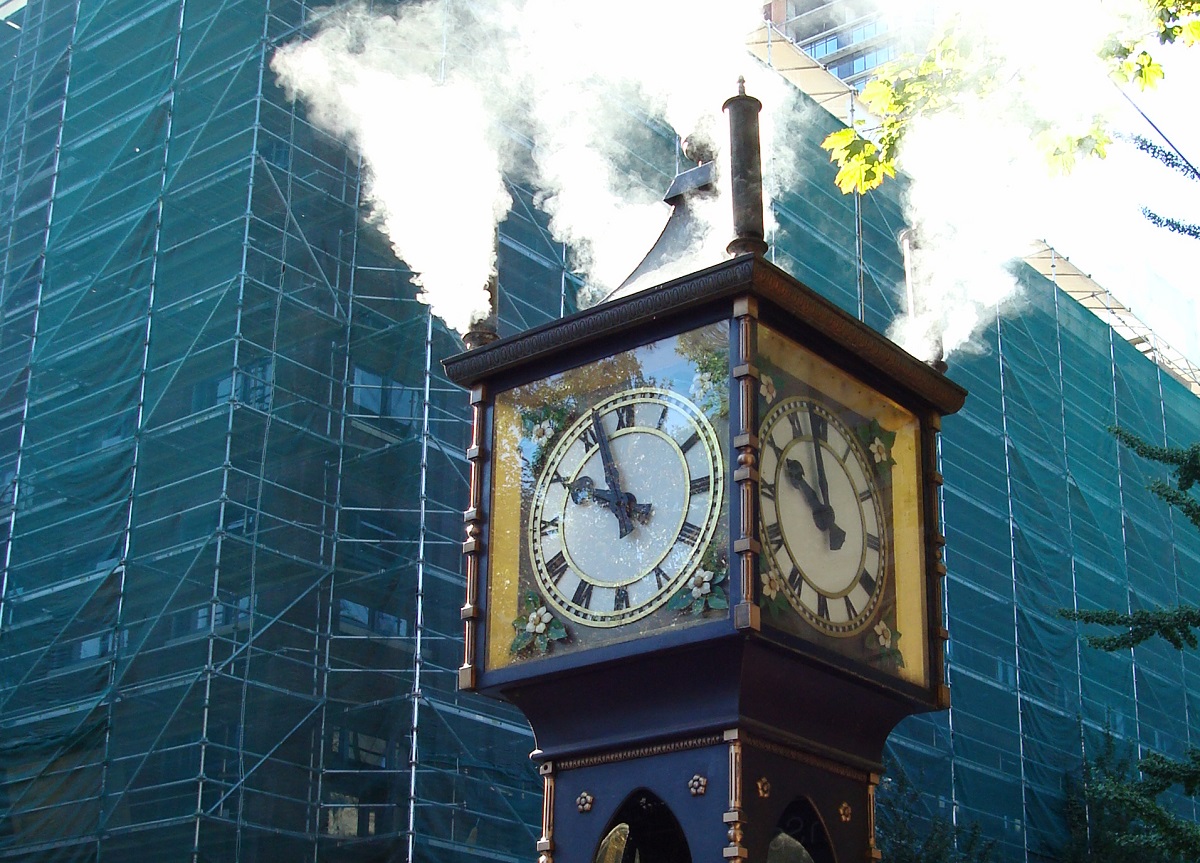
The Gastown Steam Clock is one of Vancouver’s signature attractions. It stands at Water and Cambie streets and is the world’s only steam-powered clock, which can be fully seen when the clockwork is playing.
The clock looks like a piece from the 19th century, but it was actually first put up in 1977 in a style inspired by Gastown’s youth. It was put up as part of the restoration of Gastown, which was otherwise threatened with demolition in the late 1960s in favor of a freeway and more high-rises.
Holy Rosary Cathedral is Vancouver’s Roman Catholic cathedral. The current church is not the first Catholic church in the city. There was an earlier church from 1886, but this was of modest size in relation to the growing congregation, and therefore it quickly became necessary to build a new church in order to have a suitable place to hold services for the congregation.
In 1899 the foundation stone of the present cathedral was laid, and in 1900 the church was consecrated as one of the finest architectural works in Western Canada. The cathedral is 48 meters long and 65 meters high. The style is French neo-Gothic with a characteristic vaulted roof, and on the outside the two asymmetrical towers are an architectural feature.
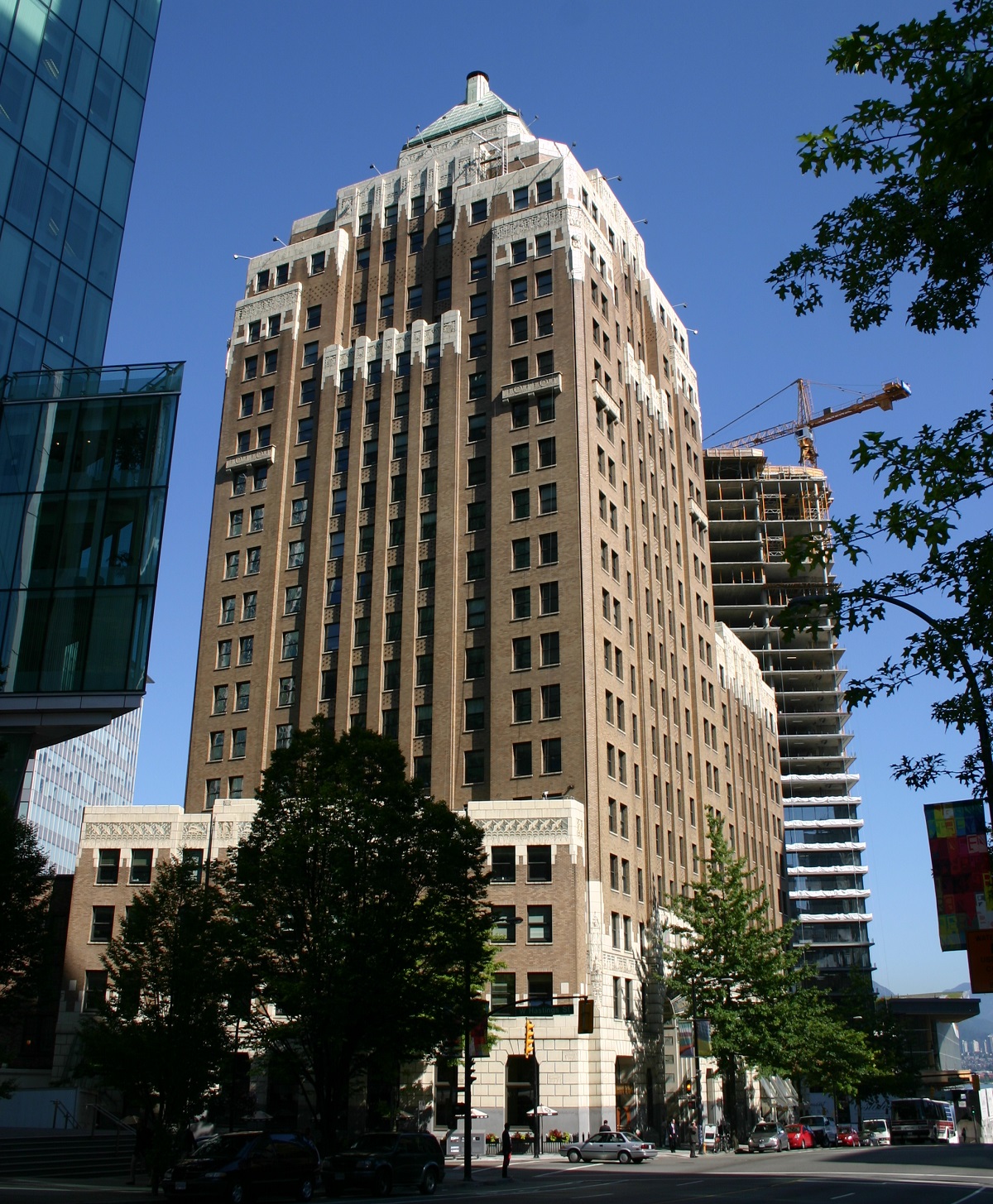
The Marine Building is a high-rise that was constructed in 1930 as Vancouver’s and the Commonwealth’s tallest building. The style was inspired by New York’s contemporary Chrysler Building, and on the Marine Building you can see various details from the art deco style; among other things at the entrance towards Burrard Street.
The height of the Marine Building is 98 metres, and the interior was richly decorated in the style of the time and with the use of skilled craftsmanship and fine materials. A detail is the variety of local woods used in the elevators behind their brass doors. One of the common themes in the design of the construction is the maritime, and both sea animals and transport are represented in different ways.
An observation deck was originally built into the top of the Marine Building and it cost 25 cents to get there. However, the time was marked by the economic depression, and too few visitors meant that the deck was closed. The financial bottleneck also meant that the building was sold for less than half the construction price as early as 1934.
The Vancouver Art Galley is Western Canada’s largest art museum. It is set up in the stately and former courthouse from the early 1900s. The building was completed in 1906 to designs by Francis Rattenbury.
The museum is known, among other things, for its large collection of works by the Canadian artist Emily Carr, but you can also see other interesting exhibitions within a wide range of works and styles.
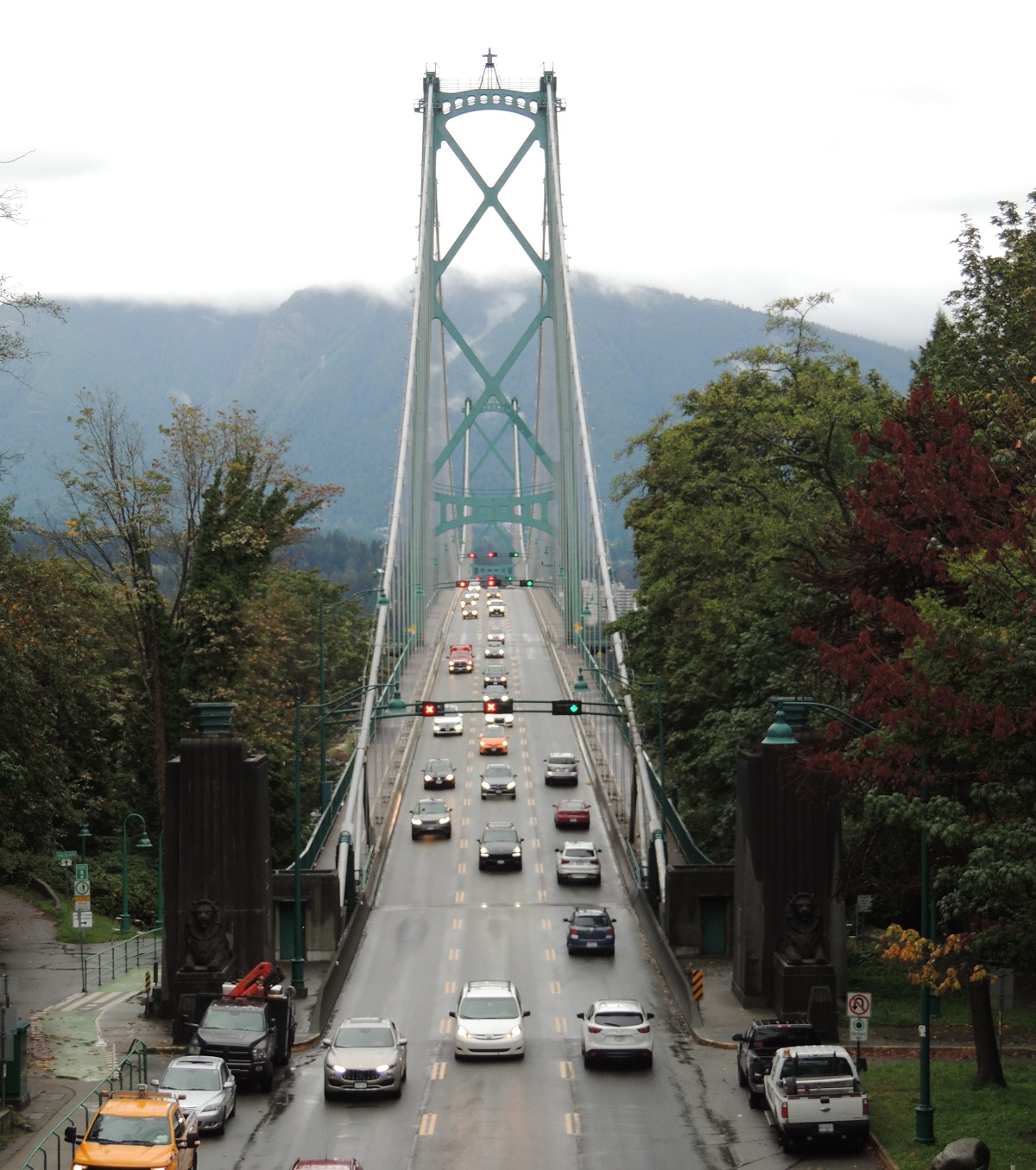
The Lions Gate Bridge is a suspension bridge that connects Stanley Park and thus the city of Vancouver with the rural areas and cities north of Vancouver Harbour. The bridge has a total length of 1,823 and has a height of 111 meters with a clearance under the bridge of 61 meters.
The bridge opened in 1938 as the First Narrows Bridge. Later, the name Lion Gate was added, which refers to the mountains The Lions, located a little north of Vancouver and the bridge. In 1939, two lion statues were erected on either side of the bridge’s approach from the south; the statues were prepared by the artist Charles Marega.
Vancouver City Hall is Vancouver’s city hall and thus the seat of the city council in the Canadian metropolis. It is a building that was built in art deco in the years 1935-1936, and as a central element in the symmetrical design stands the town hall’s twelve-storey tower with 98 meters to the top. The architects behind the design were the firm Townley & Matheson.
The beautiful building was obviously not the city’s first town hall when it was built. In the years 1897-1929, the town hall was located in Main Street by the Carnegie Library, which the then town hall building became part of in 1929, when the town government moved to The Holden Building. The Holden had been built in 1911 and thus was not intended for a function as a town hall, which was then also only a temporary solution.
Gerry McGeer became mayor in 1934 and he set up a task force to identify a site for a new town hall. The result was the current site, making Vancouver the first city in Canada to build a city hall outside of the city’s downtown.
In front of the town hall you can see a statue of George Vancouver. It was dedicated by the Lord Mayor of London, Sir Percy Vincent, on 20 August 1936 when he visited the city. The statue was prepared by the artist Charles Marega.
The Museum of Anthropology is Vancouver’s anthropological museum, which with its rich collection illuminates the culture and peoples of the Canadian Pacific region. Here is, among other things, a distinguished exhibition of Native American art and useful items such as masks and totem poles. The museum also has a collection of international effects and depictions of people from all over the world.
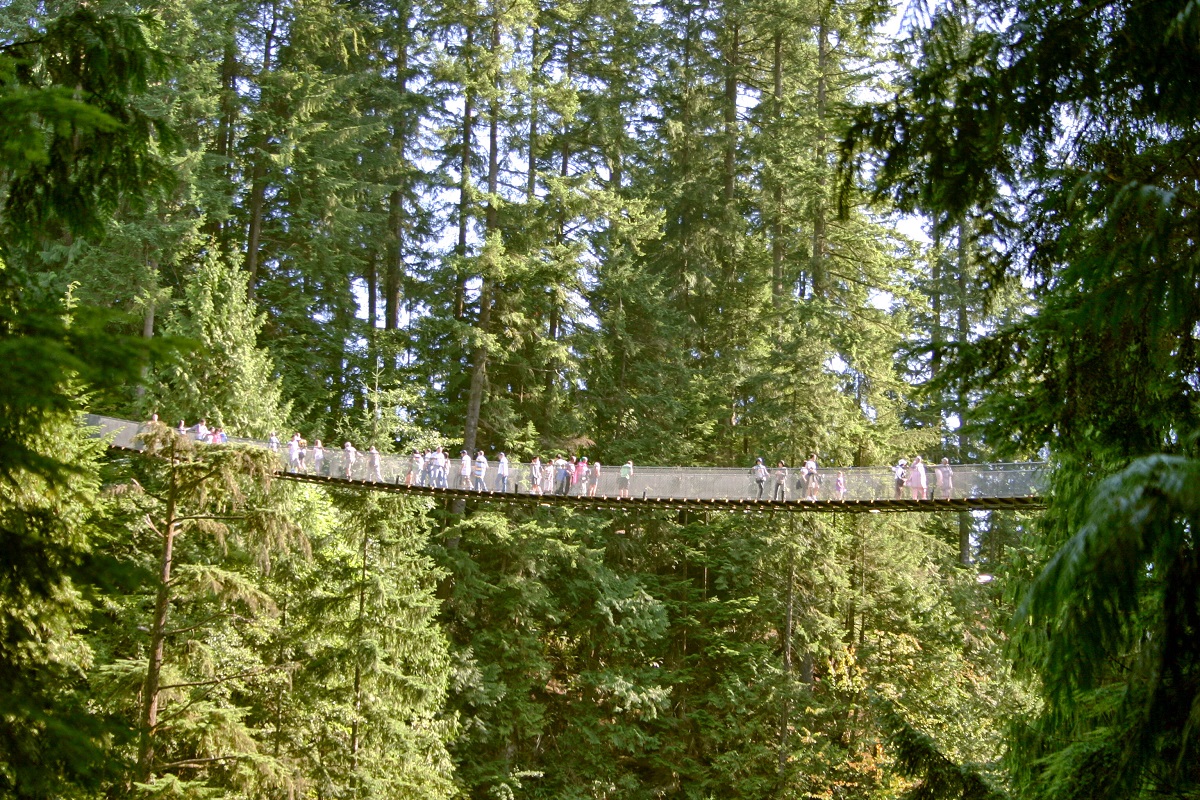
In the great coniferous forests just north of Vancouver, it’s like being far out in the wilds of Canada. You walk between the tall trees and over the rushing Capilano River, which flows at the bottom of a canyon. Here you can see the Capilano Suspension Bridge, which since 1889 has attracted tourists to the beautiful nature.
It was Scotsman George Grant McKay who built the bridge as a connection to his lands on either side of the river. The current bridge is a construction from 1956. The suspension bridge is no wider than a couple of people. It is, on the other hand, 140 meters long, and there are 70 meters to the river under the bridge.
In the park at the Capilano Suspension Bridge, you can also visit the Totem Park, where local Indian tribes erected totem poles in the 1930s, and these have been maintained in their original designs and colors.
Britannia Mine Museum is a mining museum where you literally get below the surface of the area’s history. Mining has played a significant role in British Columbia’s development, and the museum depicts it in detail in a real mine.
The history of the mine started in 1899, when the engineer George Robinson gathered the necessary financial support to begin investigations of the underground. The first ore was shipped out in 1904, and thereafter expansion and continued production progressed rapidly. In 1916, 2,000 tons of ore were produced per day.
At the museum, the construction of a mine is reviewed, and you can see and feel stones, minerals and fossils that have been dug out of the mine. Then there is a guided tour through a mine tunnel that was dug in 1912. The experience also includes a ride on a real mine train, and you can also try your hand at panning for gold.
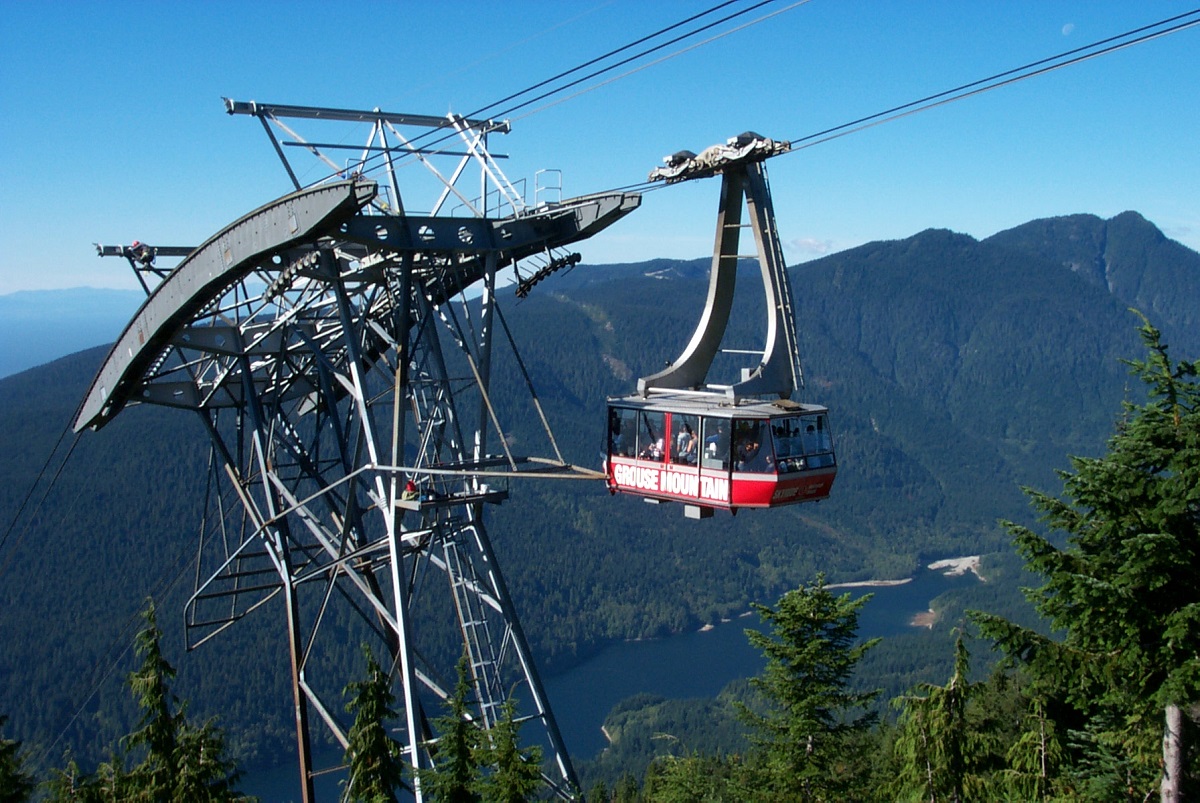
Grouse Mountain is a favorite excursion destination, where from a height of 1,200 meters you have a fantastic view of the Vancouver area. At the same time, the mountain gives a fine impression of British Columbia’s beautiful nature, and there are various activities here depending on the season.
The transport up the mountain is breathtaking with the Grouse Mountain Skyride cable car, which soars above the landscape with the many Douglas firs. The course is in operation all year round, and in both summer and winter there are activities at Grouse Mountain, which also serves as a favorite ski area for the people of Vancouver.
Fort Langley is a prime example of Canada’s fur trading posts. The fort was built in 1827 by the Hudson’s Bay Company. You can experience the life of the time at a trading post and see several contemporary reconstructed buildings. Fort Langley is a historic site and it was here that British Columbia was proclaimed as an English Crown Colony in 1858.
Seattle is an American metropolis in the northwestern corner of the United States and one of the technological centers in the country. At the same time the city has been particularly significant for recent American music. Of course, there are many sights as well, and the fact that the city is surrounded by magnificent scenery is something that just adds extra perspectives on a trip to here.
Seattle’s history is intriguing, for example, it has been the transit site for the gold diggers on their way to Canadian Klondike, which you can get acquainted with at one of the city’s museums. Seattle burned down in 1889, creating a new start for the city after the fire by raising the street level. You can see Seattle from before 1889 in the underground today. Later on, Seattle hosted the World Exhibition in 1962, and it also left its mark on the city’s skyline.
Victoria is the capital and one of the largest cities of the Canadian province of British Columbia. The area around present-day Victoria was explored from 1790, when Spaniards sailed into natural harbors on the southern tip of Vancouver Island. In 1841, James Douglas was given the task of establishing a trading post here, and in 1843 the Hudson’s Bay Company founded Fort Victoria, not least for the prosperous fur trade.
The fort was named after Queen Victoria, and the site became the capital of the British Crown Colony on the island, which was established in 1849. There were approximately 300 inhabitants in the town in 1858, when rumors of gold discoveries in British Columbia reached California. The town became a transit point for many gold miners, and Victoria grew in a few days to more than 5,000 inhabitants.
123 Carrie Cates Court
lonsdalequay.com
650 W 41st Avenue
oakride.shopping.ca
4700 Kingsway
metropolis.shopping.ca
910-609 Granville Street
1055 W Georgia Street
royalcentre.com
Granville Street, Robson Street, Yaletown, Granville Island
Vancouver Aquarium
Stanley Park
vanaqua.org
Greater Vancouver Zoo
5048 264th Street
greatervancouverzoo.com
Science World
1455 Québec Street
scienceworld.bc.ca
It is thought that the first people arrived in the Vancouver area from Asia about 10,000 years ago. They later became the area’s many different Native American tribes, developing communities in the rich natural areas.
It was tribal musqueam, sqaumish and tseil-waututh who inhabited the area through the many centuries before Europeans arrived, and they established themselves in several places in the present urban area of Vancouver; among others in Stanley Park.
In the 16th to 17th centuries, Spaniards began to gain European interest in the region as they sailed the waters off the coast and demanded dominion over the western American coastlines. It was Captain José María Narváez who, as the first, sailed into the Strait of Georgia and thereby into where Vancouver was later founded. Narváez’s journey took place in 1791.
The following year was a new Spanish expedition at Point Gray, where they met a British expedition led by Captain George Vancouver. They explored on that occasion together the Strait of Georgia, and on the same voyage George Vancouver also sailed along Puget Sound and thereby the future location of American Seattle.
George Vancouver brought his officer Peter Puget to the area of Vancouver today before the Spaniards. They landed on the site that was later named Point Gray. However, to this day there are also Spanish-sounding names in Vancouver as evidence of the former Spanish period in which they had settled around the current Friendly Cove.
Vancouver was first reached by sea, but in the decade following George Vancouver’s exploration, Simon Fraser reached the first European area and coast from the east, thereby overland in 1808. He arrived along the river, later named after him.
Settlements had been established at English Bay and Burrard Inlet, but these were developing rapidly through the early 1800s. It was the New Westminster settlement on the Fraser River southeast of the modern city center that was the spot for traffic and commerce with the interior of British Columbia.
During this time, the borders were not yet permanently set in the region, which had interests from both the UK and the US, which had not yet extended to the area that has today. With the 1818 treaty in 1818 and the Oregon treaty in 1846 between the two countries, it was agreed to divide the land at the 49th latitude, forcing Britain to give up the Oregon Territory, which later became the states of Oregon, Idaho and Washington. The United States had to give up land north of present-day Montana to the British. For Vancouver, the treaty meant that the settlements and thereby the future urban development in and around Vancouver became British and therefore part of the later established Canada.
In 1827, the Hudson’s Bay Company established a trading station on the Fraser River, becoming the first English representation in the area and the first permanent non-Native American settlement. The trading station and the English plants were continuously expanded with, among other things, a sawmill, so that both timber and furs could be traded. Fort Langley was, in that sense, the modern foundation of what turned into Vancouver and British Columbia over the decades.
The trading station began to develop explosively in 1858 when gold was found in the Fraser River. It turned into Fraser Canyon Gold Rush, where about 25,000 people came to the area in a few weeks. Over the next decade, the area was developed and, for example, transport routes were constructed through Fraser Canyon.
1858 was also the year in which the region around present-day Vancouver was established as the Crown Colony of British Columbia. The colony’s capital became New Westminster, and at that time there was no such thing as Vancouver let alone urban development. In 1866 the colony was merged with The Colony of Vancouver Island and they became the capital of Victoria to British Columbia.
In 1867, the sawmill mill Hastings Mill was established on the south side of the Burrard Inlet, and it was the first commercial activity at the site that turned into Vancouver over the years. Initially, Hastings Mill and thereby the early city was a kind of business town that operated both a store and a school.
However, the new town developed rapidly as John “Gassy Jack” Deighton came to the area in 1867 and opened a saloon that became a success among the workers at Hastings Mill. It became the foundation for several acts that together formed Gastown; Named after Gassy Jack, who got his name from his many great stories with some warm air in. Gastown officially came to be called Granville just three years later, and it was a real city.
In 1886, Granville changed its name to Vancouver, where 1,000 people now lived. It was on its way to becoming the leader in British Columbia, not least because the Canadian Pacific Railway had chosen Vancouver as the terminus for their Montreal transcontinental railroad. Vancouver had been chosen because of the great development potential of the city’s natural harbor.
In 1885, the last nail was struck in the tracks of the British Columbia railroad, and on May 23, 1887, the # 374 train pulled the first train to Vancouver, making it much easier to reach from the Atlantic coast and major cities east of Canada.
In 1886 Vancouver was hit by an almost devastating fire. The town burned down, but was quickly rebuilt. The fire, in its turn, proved to be a benefit to Vancouver, whose reconstruction was undertaken with modern infrastructure rather than having to build on outdated installations. Thus, the city rose again with new systems for water, electricity and so on.
The following years, the city’s growth exploded. Great immigration occurred and a tram network was established, and the city’s streets and modern buildings caught fire. The first skyscraper, the Dominion Trust Building, was built as early as 1909. From about 1,000 inhabitants in 1886, approximately 14,000 lived in 1901, and just ten years later the population had next doubled to 120,000.
In 1920, Vancouver became Western Canada’s largest city, and both economically and culturally the city’s flourishing continued. The city’s university had, among other things, been opened a few years before. In 1938, the Lions Gate Bridge opened, further enabling an expansion in the city’s now northern suburbs. It was almost a long ride for Vancouver, which by about 1900 had overtaken Victoria as the most economically important city in western Canada.
In the decades following the end of World War II, the expansion of Vancouver, whose port continued to be one of the city’s many assets. Much was still being built, for example at Empire Stadium, which was to host the Great British Sports & Commonwealth Games, in 1954. It provided a sporting boost to Vancouver, and over the following decades, the city’s sports clubs were successful in the Canadian tournaments. with multiple championships.
The city’s population also grew significantly in the decades following the war. By 1951, the number of citizens had reached 562,000, and the million were rounded in 1971.
Since the 1980s, construction has continued in downtown Vancouver, Skytrain has been established as a fine transport network, and many cultural offerings and activities have seen the light of day; an example is the city’s main library. Gastown was the district where Vancouver started, and during those decades it also underwent a transformation from a run-down neighborhood into a restored and popular area where you can get acquainted with early Granville and Vancouver.
The city of Vancouver has several times been selected as one of the best in the world to live in, and as a visitor it was noted during the Olympic Winter Games, which were conducted here in 2010.

Overview of Vancouver
The Western Canadian metropolis of Vancouver is one of the most beautifully located cities in the world, and nature alone in and around it makes any trip to here an unforgettable experience.
The first European came ashore in the area in 1792, and since then a colossal development has taken place here. Vancouver is one of Canada’s largest cities, and it is the economic and tourist locomotive of British Columbia; sharply followed by cruises and trips to the Victoria and Rocky Mountains, which are all easy accessible from the city.
About the upcoming Vancouver travel guide
About the travel guide
The Vancouver travel guide gives you an overview of the sights and activities of the Canadian city. Read about top sights and other sights, and get a tour guide with tour suggestions and detailed descriptions of all the city’s most important churches, monuments, mansions, museums, etc.
Vancouver is waiting for you, and at vamados.com you can also find cheap flights and great deals on hotels for your trip. You just select your travel dates and then you get flight and accommodation suggestions in and around the city.
Read more about Vancouver and Canada
Buy the travel guide
Click the “Add to Cart” button to purchase the travel guide. After that you will come to the payment, where you enter the purchase and payment information. Upon payment of the travel guide, you will immediately receive a receipt with a link to download your purchase. You can download the travel guide immediately or use the download link in the email later.
Use the travel guide
When you buy the travel guide to Vancouver you get the book online so you can have it on your phone, tablet or computer – and of course you can choose to print it. Use the maps and tour suggestions and you will have a good and content-rich journey.
Gassy Jack • Granville Island • Stanley Park • Totem Poles • Steam Clock

Overview of Vancouver
The Western Canadian metropolis of Vancouver is one of the most beautifully located cities in the world, and nature alone in and around it makes any trip to here an unforgettable experience.
The first European came ashore in the area in 1792, and since then a colossal development has taken place here. Vancouver is one of Canada’s largest cities, and it is the economic and tourist locomotive of British Columbia; sharply followed by cruises and trips to the Victoria and Rocky Mountains, which are all easy accessible from the city.
About the upcoming Vancouver travel guide
About the travel guide
The Vancouver travel guide gives you an overview of the sights and activities of the Canadian city. Read about top sights and other sights, and get a tour guide with tour suggestions and detailed descriptions of all the city’s most important churches, monuments, mansions, museums, etc.
Vancouver is waiting for you, and at vamados.com you can also find cheap flights and great deals on hotels for your trip. You just select your travel dates and then you get flight and accommodation suggestions in and around the city.
Read more about Vancouver and Canada
Buy the travel guide
Click the “Add to Cart” button to purchase the travel guide. After that you will come to the payment, where you enter the purchase and payment information. Upon payment of the travel guide, you will immediately receive a receipt with a link to download your purchase. You can download the travel guide immediately or use the download link in the email later.
Use the travel guide
When you buy the travel guide to Vancouver you get the book online so you can have it on your phone, tablet or computer – and of course you can choose to print it. Use the maps and tour suggestions and you will have a good and content-rich journey.

Christ Church Cathedral is the main Anglican church in Vancouver. The first steps towards the construction of the church were taken in 1888, and the following year the first service was held for 52 parishioners in a building which the surrounding landowners did not think was worthy of a church.
There was a pronounced local desire to build a new church. In order to succeed in the wish, shares were sold and loans were taken out. After that, the construction of today’s church could start, and the church was built in 1894-1895 in neo-Gothic style. Inside you can see, among other things, 32 glass mosaics that were prepared in England and Canada respectively.
Today, the church, which at the time of construction was of considerable relative size in the cityscape, stands as a low building among surrounding high-rise buildings. It provides a good contrast in the urban space and emphasizes the development that Vancouver has undergone since the end of the 1800s.
Vancouver is home to North America’s second largest Chinese population and the largest in Canada. In the streets Pender Street and Keefer Street, the Chinese make their mark, not least with shops and restaurants like in their home country, and collectively the area is called Chinatown.
Also in Pender Street, you can see the Chinese gate with the name Millennium Gate. Various Chinese festivals and traditions are celebrated in style in this neighborhood; e.g. the Chinese New Year. In the streets of Chinatown, you can also notice details in the decoration. The street lamps are an example of the Chinese style, deliberately installed to give the neighborhood a distinctive character.
The Chinese population traditionally lived in this area of the city, but from the 1900s to today, they have spread more throughout the city area. As a result, there is not the same concentration of Chinese culture and daily life as there has been in the past. A kind of new Chinese trade center has also seen today’s life in the Richmond district.

The Gastown Steam Clock is one of Vancouver’s signature attractions. It stands at Water and Cambie streets and is the world’s only steam-powered clock, which can be fully seen when the clockwork is playing.
The clock looks like a piece from the 19th century, but it was actually first put up in 1977 in a style inspired by Gastown’s youth. It was put up as part of the restoration of Gastown, which was otherwise threatened with demolition in the late 1960s in favor of a freeway and more high-rises.
Holy Rosary Cathedral is Vancouver’s Roman Catholic cathedral. The current church is not the first Catholic church in the city. There was an earlier church from 1886, but this was of modest size in relation to the growing congregation, and therefore it quickly became necessary to build a new church in order to have a suitable place to hold services for the congregation.
In 1899 the foundation stone of the present cathedral was laid, and in 1900 the church was consecrated as one of the finest architectural works in Western Canada. The cathedral is 48 meters long and 65 meters high. The style is French neo-Gothic with a characteristic vaulted roof, and on the outside the two asymmetrical towers are an architectural feature.

The Marine Building is a high-rise that was constructed in 1930 as Vancouver’s and the Commonwealth’s tallest building. The style was inspired by New York’s contemporary Chrysler Building, and on the Marine Building you can see various details from the art deco style; among other things at the entrance towards Burrard Street.
The height of the Marine Building is 98 metres, and the interior was richly decorated in the style of the time and with the use of skilled craftsmanship and fine materials. A detail is the variety of local woods used in the elevators behind their brass doors. One of the common themes in the design of the construction is the maritime, and both sea animals and transport are represented in different ways.
An observation deck was originally built into the top of the Marine Building and it cost 25 cents to get there. However, the time was marked by the economic depression, and too few visitors meant that the deck was closed. The financial bottleneck also meant that the building was sold for less than half the construction price as early as 1934.
The Vancouver Art Galley is Western Canada’s largest art museum. It is set up in the stately and former courthouse from the early 1900s. The building was completed in 1906 to designs by Francis Rattenbury.
The museum is known, among other things, for its large collection of works by the Canadian artist Emily Carr, but you can also see other interesting exhibitions within a wide range of works and styles.

The Lions Gate Bridge is a suspension bridge that connects Stanley Park and thus the city of Vancouver with the rural areas and cities north of Vancouver Harbour. The bridge has a total length of 1,823 and has a height of 111 meters with a clearance under the bridge of 61 meters.
The bridge opened in 1938 as the First Narrows Bridge. Later, the name Lion Gate was added, which refers to the mountains The Lions, located a little north of Vancouver and the bridge. In 1939, two lion statues were erected on either side of the bridge’s approach from the south; the statues were prepared by the artist Charles Marega.
Vancouver City Hall is Vancouver’s city hall and thus the seat of the city council in the Canadian metropolis. It is a building that was built in art deco in the years 1935-1936, and as a central element in the symmetrical design stands the town hall’s twelve-storey tower with 98 meters to the top. The architects behind the design were the firm Townley & Matheson.
The beautiful building was obviously not the city’s first town hall when it was built. In the years 1897-1929, the town hall was located in Main Street by the Carnegie Library, which the then town hall building became part of in 1929, when the town government moved to The Holden Building. The Holden had been built in 1911 and thus was not intended for a function as a town hall, which was then also only a temporary solution.
Gerry McGeer became mayor in 1934 and he set up a task force to identify a site for a new town hall. The result was the current site, making Vancouver the first city in Canada to build a city hall outside of the city’s downtown.
In front of the town hall you can see a statue of George Vancouver. It was dedicated by the Lord Mayor of London, Sir Percy Vincent, on 20 August 1936 when he visited the city. The statue was prepared by the artist Charles Marega.
The Museum of Anthropology is Vancouver’s anthropological museum, which with its rich collection illuminates the culture and peoples of the Canadian Pacific region. Here is, among other things, a distinguished exhibition of Native American art and useful items such as masks and totem poles. The museum also has a collection of international effects and depictions of people from all over the world.
Similar to Vancouver Travel Guide